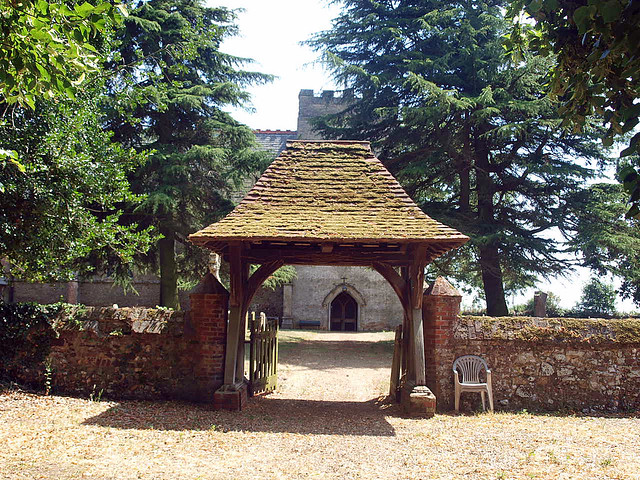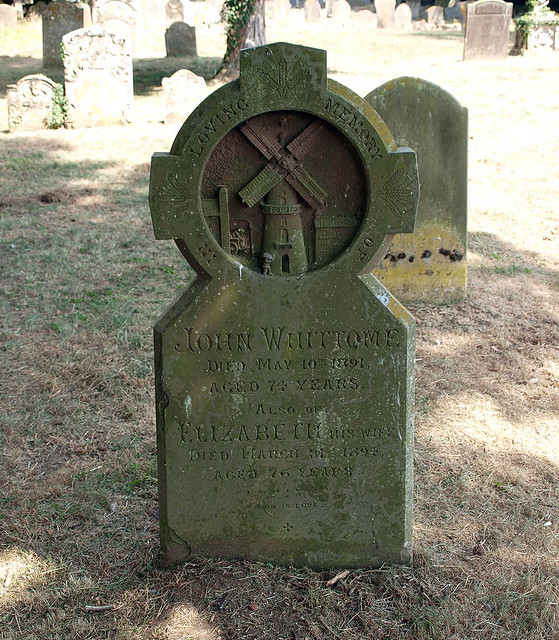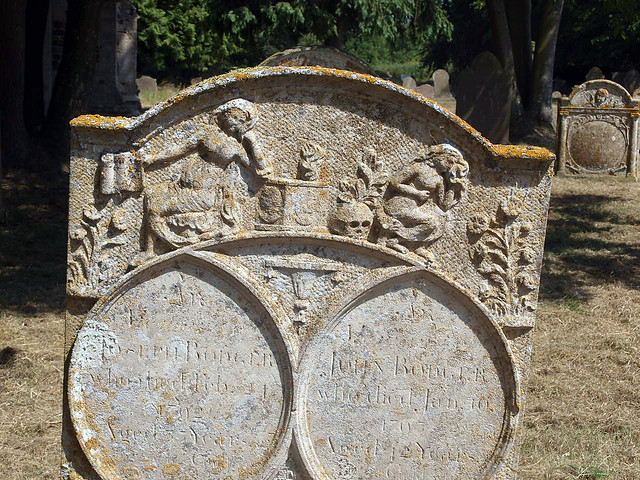ALL SAINTS. An avenue of lime trees leads to the church. This consists of a medieval body severely restored by Street in 1869-70 and a grey-brick tower of 1794. The body of the church is of small brown stone and was low in Ladbrooke’s time (c.1825). Street gave the nave a steep-pitched roof dwarfing the tower (which perhaps he intended to replace later). At the E end he added a chancel extending as far E as earlier foundations went. That early chancel must however have been abolished early; for inside, where Street left what he had found, there is a two-bay arcade of relatively low and narrow arches towards a former S chapel and a wide and tall two-bay arcade towards a former S aisle. But the (very wide) Perp aisle, as it is, runs to the E end of the S chapel. It has its original roof to that extent, a coarse roof with arched braces and some tracery above the inner brace. The arcade seems to be of the C14, the remodelling of the C15. - PULPIT. Of stone, probably by Street. - SCREEN. Simple, of one-light divisions, now in the tower arch. - MONUMENT. Henry Hawe d. 1592. Tablet with small kneeling figures.
HILGAY. The Fens are at its doorstep, but its narrow street climbs the hill from the River Wissey flowing to the Ouse. Into its view across the river comes the 17th-century Snowre Hall, fascinating with secret chambers, and having a link with Charles Stuart, who is said to have sheltered here before his surrender at Newark.
A lovely avenue of 60 tall limes with holly trees and holly hedges, and a lych gate at each end, brings us to the churchyard. The stumpy brick tower just topping the nave comes from the 18th century, and from it George Manby is said to have practised firing his life-line. The 14th-century nave has a leaning arcade of two tall and two low arches, and the chancel is made new. The modern chancel screen has a vine cornice, and old tracery remains in the screen of the chapel where, on a fine little alabaster wall monument, Henry Hawe is kneeling with his wife and daughter at a prayer desk. Henry was lord of the manor and died in 1592. One of the 17th-century rectors was Phineas Fletcher, who wrote The Purple Island (Isle of Man), in imitation of Spenser’s Faery Queene. The poem is an allegory surveying the vices and virtues of Man; it represents the body as an island, with the bones as foundations, the veins as books, and so on. Some of it has power, but it is forgotten.
Wood Hall, the one fine old house here, was once a grange of the abbots of Ramsey, but we remember it best as the home of one whose invention was an inestimable boon to mankind. He was George William Manby, a school friend of Nelson, and inventor of the rocket apparatus for saving life from shipwreck. Born at Denver close by, he came here to live when his father became lord of the manor, and when he died (at his house at Yarmouth) they brought him to rest in this churchyard. On the stone marking his grave are carved a ship, an anchor, and his mortar for firing a line to a wreck. His memorial, next to one to his parents, says that his is a name to be remembered as long as there can be a stranded ship, and the inscription ends with the curious words, The public should have paid this tribute.
The Manbys were a martial family. The father, who had served in the marines, died a captain of Welsh Fusiliers. William’s brother Thomas was a naval captain with a thrilling career, during which he experienced the vicissitudes of the tropics and the Arctic and wrecked his constitution.
George William was at school with Nelson. A versatile and scholarly man, he wrote on antiquarian and topographical subjects, but a pamphlet on the expected invasion of Napoleon attracted the notice of Whitehall, and he was made master of the barracks at Yarmouth. Here he was shocked by the wreck of a Government ship close in shore, with scores of men perishing before his eyes. There existed no means by which those looking on could save them, and the tragedy set Manby thinking. He had known his subject for years, for as a boy he had fired a rope over Downham Church, and he now adapted his schoolboy idea by rocketing a rope to a ship. Within a year the life-line was first fired in earnest for the assistance of the wrecked brig Elizabeth, and the device was widely adopted. Manby introduced improvements into the building of lifeboats. Trained to war and the destroying of life, he excelled in saving it.
A lovely avenue of 60 tall limes with holly trees and holly hedges, and a lych gate at each end, brings us to the churchyard. The stumpy brick tower just topping the nave comes from the 18th century, and from it George Manby is said to have practised firing his life-line. The 14th-century nave has a leaning arcade of two tall and two low arches, and the chancel is made new. The modern chancel screen has a vine cornice, and old tracery remains in the screen of the chapel where, on a fine little alabaster wall monument, Henry Hawe is kneeling with his wife and daughter at a prayer desk. Henry was lord of the manor and died in 1592. One of the 17th-century rectors was Phineas Fletcher, who wrote The Purple Island (Isle of Man), in imitation of Spenser’s Faery Queene. The poem is an allegory surveying the vices and virtues of Man; it represents the body as an island, with the bones as foundations, the veins as books, and so on. Some of it has power, but it is forgotten.
Wood Hall, the one fine old house here, was once a grange of the abbots of Ramsey, but we remember it best as the home of one whose invention was an inestimable boon to mankind. He was George William Manby, a school friend of Nelson, and inventor of the rocket apparatus for saving life from shipwreck. Born at Denver close by, he came here to live when his father became lord of the manor, and when he died (at his house at Yarmouth) they brought him to rest in this churchyard. On the stone marking his grave are carved a ship, an anchor, and his mortar for firing a line to a wreck. His memorial, next to one to his parents, says that his is a name to be remembered as long as there can be a stranded ship, and the inscription ends with the curious words, The public should have paid this tribute.
The Manbys were a martial family. The father, who had served in the marines, died a captain of Welsh Fusiliers. William’s brother Thomas was a naval captain with a thrilling career, during which he experienced the vicissitudes of the tropics and the Arctic and wrecked his constitution.
George William was at school with Nelson. A versatile and scholarly man, he wrote on antiquarian and topographical subjects, but a pamphlet on the expected invasion of Napoleon attracted the notice of Whitehall, and he was made master of the barracks at Yarmouth. Here he was shocked by the wreck of a Government ship close in shore, with scores of men perishing before his eyes. There existed no means by which those looking on could save them, and the tragedy set Manby thinking. He had known his subject for years, for as a boy he had fired a rope over Downham Church, and he now adapted his schoolboy idea by rocketing a rope to a ship. Within a year the life-line was first fired in earnest for the assistance of the wrecked brig Elizabeth, and the device was widely adopted. Manby introduced improvements into the building of lifeboats. Trained to war and the destroying of life, he excelled in saving it.



No comments:
Post a Comment